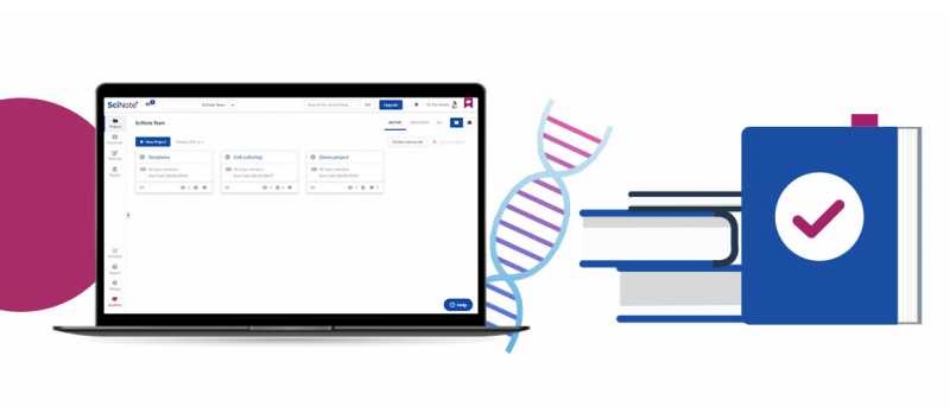Managing and Saving Scientific Data: Going from Paper to Electronic Lab Notebooks and to DNA Storage
![]() 5 min read
5 min read
Science plays a big role in generating an ever increasing amounts of data. We are able to produce the “big data” with a single experiment. IDC reports that from 2005 to 2020, the so called digital universe will grow by a factor of 300, from 130 exabytes to 40,000 exabytes, or 40 trillion gigabytes, which is more than 5,200 gigabytes for every man, woman, and child by 2020.
Databases are growing exponentially, thanks mostly to dropping costs and increased automation. The maintenance of all this data on hard drives is pressing the budget to the breaking point.
So when it comes to paper aficionados, paper has been an excellent media to store, distribute and share information. Paper does indeed have several benefits. No need for electricity or battery, they are affordable and to some extend portable (Grass & co, 2015). However loss of information is a major issue of laboratory records that are not being digitized and stored in a systematic way. The fact that 17% of all research data is lost annually poses a great reusability and repeatability problem, enormous additional cost and extreme limitation for knowledge sharing and knowledge base expansion within one organisation and throughout the community. The problem of data loss and knowledge transfer is especially notable if a researcher leaves the laboratory.
Loss of information is a major issue of laboratory records that are not being digitised and stored in a systematic way.
So imagine that a researcher that has been working in your research group for 5 years, leaves and starts building his career elsewhere. He has left his lab notebooks at the University, however his notes are hard to decipher and no one can really find the raw data files. Although he has left only 6 months ago, all the results, including the negative ones and the conclusions drawn out of the research are lost. The only thing that is left are his published scientific papers. It is impossible to do the comparisons or reuse the data. The University has thrown away a significant amount of money.
Electronic Lab Notebook (ELN) software solutions available today enable the smoothest transfer from paper notes to digital notes. ELNs help to systematically store the data and researchers are able to share the data among colleagues who are working on the same project. Everyone can then build up upon the same data and avoid unnecessary experiment duplication. With advanced search function and timestamp ELNs guarantee full traceability which minimizes the possibility of losing the data.
It will be crucial for an ELN to be interoperable, offering researchers limitless possibilities to manage their data in one place.
It will take some time though before electronic lab notebooks (ELN) are fully accepted and used in every lab. But there is no reason why paper and digital notes could not coexist. If you prefer to have a hard copy of the information, you can use the electronic lab notebook to prepare the report, print it out, sign it and store it in the archive. Although the transition is hard, ELNs unquestionably add a lot of value to the research processes.
Nowadays companies that design ELNs understand the needs of researchers and are designing user-friendly software solutions. Moreover, the development is taking the path towards interoperability, which means that ELNs will be able to communicate with laboratory instruments, other software and online databases. In the very near future it will be crucial for an ELN to be interoperable, offering researchers limitless possibilities to manage their data in one place.
We should also not forget that the growing amount of data requires hardware capable of storing such quantities. Ewan Birney & Nick Goldman from EBI explain that databases are growing exponentially, thanks mostly to dropping costs and increased automation. However, the maintenance of all this data on hard drives is pressing the budget to the breaking point. So is there a way to store the data in a more compact form? We got the answer from the nature itself – the DNA molecule. It is able to store more data than any disc or server in a very small volume. It’s chemical structure guarantees stability in almost any harsh condition, giving us the possibility to store any data for millennia.
DNA is able to store more data than any disc or server in a very small volume.
Birney and Goldman calculated that if you wanted to put a file in storage today and have it last for at least 600 years, DNA would be more affordable than re-recording the data to fresh magnetic tape, which is a current gold standard thanks to its low power demands compared to hard drives or other storage technologies. The process would then needed to be repeated every half-decade or so and altogether 120 times over the six-century span.
We can agree that cutting-edge technology amplifies the intelligence and potential of the people at the heart of science. The reason of our hesitation to change from paper to digital mostly lies in our own reluctance to change. Was it intuitive for you to use touch screen on your phone when you first had to get one? Now it is time to start digitizing your research work. And this will significantly improve the way everyone is doing science.
Tea Pavlek, MSc and Jana Erjavec, PhD





